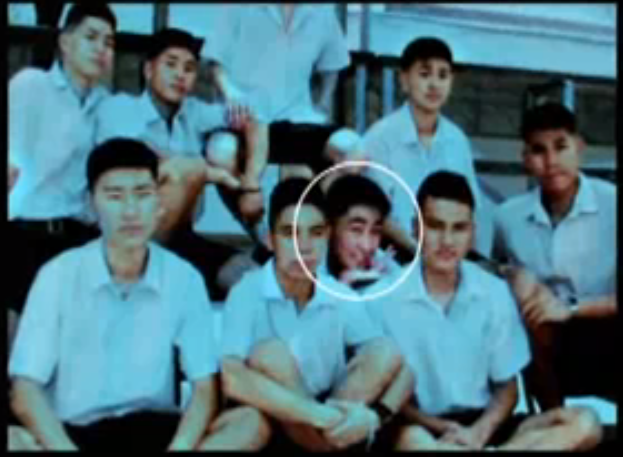
Photos reveal queerness in Thai comedy
The trailer for recent Thai comedy Metrosexual (Yongyooth Thongkongtoon, 2006) is catnip for the queer film scholar. Parodying the trailer for hit horror film Shutter (Banjong Pisanthanakun and Parkpoom Wongpoom, 2004), it begins with a series of seemingly innocuous photographs – everyday snaps of families, groups of friends and social events – only to run the series again, this time circling something previously unnoticed in each shot: a queer in the background, or a suspicious figure, or a wandering hand.
 The tagline is “They are around us” and the joke seems to be a homophobic one – just like ghosts, queers are secretly among us, perhaps even closer than ‘we’ imagined. The image below is altered for its second appearance. In the first shot, the friend looks innocently at the camera, but in the second, he is turned to gaze adoringly at the boy whose chest he is not-so-subtly caressing on film. Images can reveal truths unavailable to the naked eye, and yet, like queers, they are not to be trusted.
The tagline is “They are around us” and the joke seems to be a homophobic one – just like ghosts, queers are secretly among us, perhaps even closer than ‘we’ imagined. The image below is altered for its second appearance. In the first shot, the friend looks innocently at the camera, but in the second, he is turned to gaze adoringly at the boy whose chest he is not-so-subtly caressing on film. Images can reveal truths unavailable to the naked eye, and yet, like queers, they are not to be trusted.
But if the joke depends on a homophobic punchline, it also plays complexly with the intersections of Thai (and Asian) genre films, world cinema, gender, and the status of the image. The trope of the supposedly ordinary photograph that on closer inspection reveals something uncanny is a cinematic figure with a long history. Michelangelo Antonioni’s Blow-Up (1966) places the uncertainty of the photographic image on the stage of international art cinema and Asian horror films from Ringu (Nakata, 1998) onward locate the media object as the centre of unsettling liminalities of category. The Metrosexual trailer plays these references for laughs, using ominous music evocative of suspenseful ghost movies, as a comedy set-up alongside images of hidden queers that evoke the hard-to-read ghost images of films like Shutter. Although the style is parodic, the trailer nonetheless directs our attention to the gender diversity lurking in the everyday, like a queer punctum piercing all of these supposedly hetero photographs.
Of course, this part of the trailer is a joke – and its second section cuts to a comedy font with a bright green color background, “Macho Man” on the soundtrack, and the viewer is introduced to the four main straight female characters. The narrative centres on these women’s efforts to discover if the fiancé of their friend is gay or just a metrosexual, and so the ability to read outward gestures of gender performance as truthful signifiers of sexual orientation becomes the key conflict of the movie.
The trailer for Metrosexual adeptly plays on anxieties that have emerged in contemporary Thai culture among traditional kathoey or third sex identities, Western gay identities, and newly visible variances in masculinity. It juxtaposes horror and comedy in order to balance the anxiety-producing aspects of the new queer masculinities with the socially reassuring promise of the romantic comedy. But as much as the film’s narrative might reassure that heterosexuality will be saved, the trailer’s punctum remains these kathoey, gay, or queer figures that the cinematic image persists in revealing.




 RSS - Posts
RSS - Posts